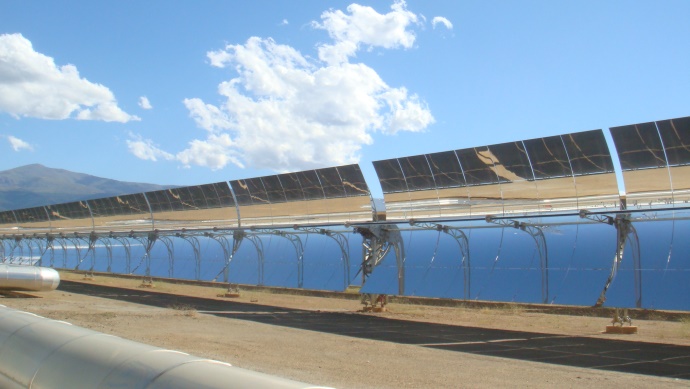Already in the middle of the 80’s of the last century parabolic trough solar power plants (CSP = Concentrated Solar Power) with a total electric capacity of more than 350 MW were erected in the Californian Mojave Desert. These plants have been steadily in operation until today.
Since the middle of 2007, the power generation using solar thermal power plants has been subsidized in Spain by a feed-in tariff above the respective market price for a period of 20 years. Through this a real “solar boom” was triggered in Spain: As per March 2011 already more than 14 power plants with a total of 700 MW of electric peak capacity are in operation in Spain, additional 28 power plants (1.400 MW) are under construction as well as additional 19 power plants (950 MW) are in concrete planning. In the next years in Spain, the installed electric total capacity of solar thermal power plants will thereby increase to more than 3.000 MW. This corresponds approximately with the capacity of four conventional coal-fired power plants or three nuclear power plants.
At an approximately power plant price of 250 million € the total investments accumulate to around 15 billion €. With this the solar thermal power generation has reached big industrial character also in Europe now.
The used technology of the solar thermal power generation thereby is extensively based on the power plants in California, for the most part however supplemented by thermal energy storage.
In parabolic trough solar power plants, the sunlight is concentrated by parabolic shaped mirrors onto a vacuum-insulated absorber tube along the focal line, in which a special heat transfer fluid (HTF – heat transfer fluid) flows and which is heated up to maximum 400 °C – the thermal stability limit of the HTF. Collectors of the current design have an opening (aperture) of just under 6 m and concentrate the solar radiation by about a factor of 80.
The heat transfer oil (HTF) releases the thermal energy via heat exchangers (preheater, vaporizer, superheater, reheater) to a conventional water / steam circuit with single reheating (steam parameter
371 °C / 100 bar / 30 bar) operating a turbine with generator. The overall process is shown schematically in the illustration alongside.
Thermal solar power plants have a number of advantages in comparison to photo-voltaic systems (PV) where solar radiation is directly converted into electricity: 1. The specific investment costs and electricity production costs are significantly below those of PV systems. 2. Due to the relatively large thermal inertia of the entire plant resulting from the widely use of large HTF volume (> 1.000 tons), the performance of a solar power plant does not break down immediately at short-term fluctuations of the radiation intensity, as it occurs for example in clouds passes.
Download the complete text about solar thermal power plants here. The text is a tranlation from the book “Wärmeträgertechnik mit organischen Fluiden” by Walter Wagner.





Comments are closed.